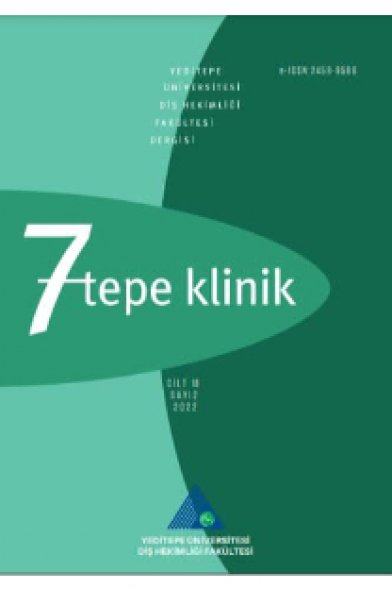Comparison of curved canal preparations by means of three different root canal curvature measurement techniques
Eğri kanalların şekillendirilmesinin üç farklı kök kanal eğimi ölçüm yöntemi ile karşılaştırılması
___
1. Weine FS, Kelly RF, Bray KE. Effect of preparation with endodontic handpieces on original canal shape. J Endod 1976; 2: 298-303.2. Abou-Rass M, Frank AL, Glick DH. The anticurvature filing method to prepare the curved root canal. J Am Dent Assoc 1980; 101: 792-794.
3. Abou-Rass M, Jann JM, Jobe D, Tsutsui F. Preparation of space for posting: effect on thickness of canal walls and incidence of perforation in molars. J Am Dent Assoc 1982; 104: 834-837.
4. Schilder H. Cleaning and shaping the root canal. Dent Clin North Am 1974;18: 269-296.
5. Eldeeb ME, Boraas JC. The effect of different files on the preparation shape of severely curved canals. Int Endod J 1985;18: 1-7.
6. Sadeghi S, Poryousef V. A novel approach in assessment of root canal curvature. Iranian Endod J 2009; 4: 131.
7. Chaniotis A. Tactile controlled activation technique with controlled memory files. Endod Prac 2016; 9: 31-36.
8. Günday M, Sazak H, Garip Y. A comparative study of three different root canal curvature measurement techniques and measuring the canal access angle in curved canals. J Endod 2005; 31: 796-798.
9. Habib AA, Taha MI, Farah EM. Methodologies used in quality assessment of root canal preparation techniques: review of the literature. J Taibah Uni Med Sci 2015;10: 123- 131.
10. Schneider SW. A comparison of canal preparations in straight and curved root canals. Oral Surg Oral Med Oral Pathol 1971; 32: 271-275.
11. Thompson S, Dummer P. Shaping ability of HERO 642 rotary nickel–titanium instruments in simulated root canals: Part 2. Int Endod J 2000; 33: 255-261.
12. Jardine S, Gulabivala K. An in vitro comparison of canal preparation using two automated rotary nickel–titanium instrumentation techniques. Int Endod J 2000; 33: 381-391.
13. Park H. A comparison of Greater Taper files, ProFiles, and stainless steel files to shape curved root canals. Oral Surg Oral Med Oral Pathol Oral Radiol Endod 2001; 91: 715-718.
14. Versümer J, Hülsmann M, Schäfers F. A comparative study of root canal preparation using ProFile. 04 and Lightspeed rotary Ni–Ti instruments. Int Endod J 2002; 35: 37-46.
15. Hülsmann M, Gressmann G, Schäfers F. A comparative study of root canal preparation using FlexMaster and HERO 642 rotary Ni–Ti instruments. Int Endod J 2003; 36: 358-366.
16. Peters OA. Current challenges and concepts in the preparation of root canal systems: a review. J Endod 2004; 30: 559-567.
17. Schäfer E, Erler M, Dammaschke T. Comparative study on the shaping ability and cleaning efficiency of rotary Mtwo instruments. Part 1. Shaping ability in simulated curved canals. Int Endod J 2006; 39: 196-202.
18. Sonntag D, Ott M, Kook K, Stachniss V. Root canal preparation with the NiTi systems K3, Mtwo and ProTaper. Aust Endod J 2007; 33: 73-81.
19. Kuzekanani M, Walsh LJ, Yousefi MA. Cleaning and shaping curved root canals: Mtwo® vs ProTaper® instruments, a lab comparison. Indian J Dent Res 2009;20:268.
20. Vahid A, Roohi N, Zayeri F. A comparative study of four rotary NiTi instruments in preserving canal curvature, preparation time and change of working length. Aust Endod J. 2009; 35: 93-97.
21. ElAyouti A, Dima E, Judenhofer MS, Löst C, Pichler BJ. Increased apical enlargement contributes to excessive dentin removal in curved root canals: a stepwise microcomputed tomography study. J Endod 2011; 37: 1580- 1584.
- ISSN: 2458-9586
- Yayın Aralığı: 3
- Başlangıç: 2005
- Yayıncı: Yeditepe Üniversitesi Rektörlüğü
Yasin Yasa, İsmail GÜMÜŞSOY, İbrahim S. BAYRAKDAR, Şuayip B. DUMAN, Binali ÇAKUR
Evaluation of maxillofacial fracture cases: A retrospective study
HATİCE HOŞGÖR, FATİH MEHMET COŞKUNSES, BAHADIR KAN
Tuba DEVELİ, Muazzez SÜZEN, NUR ALTIPARMAK, Abdullah ÖZEL, İ. Sina UÇKAN
Eğri kanalların şekillendirilmesinin üç farklı kök kanal eğimi ölçüm yöntemi ile karşılaştırılması
Dilek TÜRKAYDIN, Hesna Sazak ÖVEÇOĞLU, Seda ÖZYÖNEY, Yıldız GARİP BERKER, Mahir GÜNDAY, Fatıma Betül BAŞTÜRK
Halitosis: Periodontal hastalıklarla ilişkisi ve tedavi stratejileri
Ogül Leman TUNAR, Gizem İNCE KUKA, Hazel Zeynep KOCABAŞ, Ebru Özkan KARACA, Hare GÜRSOY, Bahar KURU
DİLEK TÜRKAYDIN, FATIMA BETÜL BAŞTÜRK, Seda ÖZYÖNEY, Yıldız GARİP BERKER, Hesna Sazak ÖVEÇOĞLU, Mahir GÜNDAY
Fatmanur KETENCİ, DEFNE YALÇIN YELER, Melike KORALTAN, YENER ÜNAL
Anterior Open Bite Treatment with Zygomatic Anchorage in Adult Patient: A case report
Defne ÇALDEMİR YANIK, Pınar ÜNLÜ KUTAY, SÖNMEZ FIRATLI
YELİZ GÜVEN, EMİNE NURSEN TOPCUOĞLU, NİLÜFER ÜSTÜN, Dicle AKSAKAL, Mehmet Ziya DOYMAZ, OYA AKTÖREN, HATİCE GÜVEN KÜLEKÇİ
